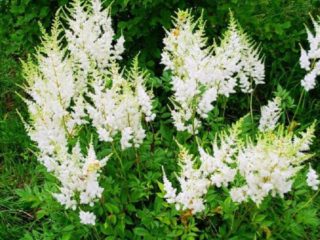Content
- 1 Is it possible to use fir oil for ARVI and colds?
- 2 The healing properties of fir oil for coughs and ARVI
- 3 Indications for use
- 4 Recipes and methods of application
- 5 Rules of application
- 6 Restrictions and contraindications
- 7 Conclusion
Fir oil for cough is one of the remedies that can be said to be “confirmed to be effective.” But this drug should not be abused. In fact, it is highly purified turpentine obtained from fir trees. Turpentine oil is obtained from all types of coniferous trees in the same way: distillation with water vapor.
Is it possible to use fir oil for ARVI and colds?
Unlike technical turpentine, fir extract is used to treat diseases. But even the first product of a very high degree of purification cannot be used internally in its pure form. This is a poison that can burn mucous membranes. For colds and runny nose, fir oil is used for inhalation. The active substances cleanse the respiratory tract well.
To cleanse the bronchi and facilitate the release of mucus, fir oil can also be used to breathe during ARVI. But you cannot seriously expect to cure a viral disease with the help of any drugs. The oil will help relieve symptoms, soften coughs and make breathing easier while the body fights the disease.
Most often, fir remedy is used in the treatment of:
- flu;
- asthma;
- bronchitis;
- pneumonia.
That is, to relieve symptoms of diseases affecting the upper respiratory tract.
As a warming component in ointments, it is used in the treatment of rheumatism. It blocks sweating, so it is used as a symptomatic remedy for hyperhidrosis.
Composition and value
The composition of turpentine oil depends on the coniferous species from which it was produced. It is richest in representatives of the fir genus. But even here, not everything is so simple. Medicinal preparations are produced only from 3 types of fir:
- white/European;
- Siberian;
- balsamic
The richest in composition is the extract from European fir.
Pure oil contains:
- limonene;
- terpintolen;
- camphene;
- cineole;
- terpinenes;
- borneol;
- bornyl acetate;
- other essential substances.
The extract from European fir also contains dodecanal and decanal.
The most valuable element of fir extract is bornyl acetate. This is borneol acetate, which performs disinfectant functions.Its content in the product is 8-47%. It is also the heaviest component of the oil. The higher the percentage of bornyl acetate, the greater the weight of the liquid. But the specific gravity of the contents of a pharmaceutical bottle is difficult to determine by eye. Therefore, when choosing a drug you will have to be guided by other principles.

This product is expensive and does not come in large bottles
Selection rules
It is impossible to visually distinguish a quality product from a fake. You will have to choose a product in a pharmacy intuitively and on the pharmacist’s word of honor. Fir extract is often not even counterfeited, but mixed with cheaper oils of similar effect:
- camphor;
- citrus;
- vegetable.
It’s good if the manufacturer immediately positions its products as a complex of substances that help with a particular problem. Depending on the composition of the “cocktail” with such fir oil, you can do inhalations for bronchitis or a runny nose. After all, other essential oils are also often used to treat coughs.
It’s worse if you bought a fake, in which fir extract was mixed with roughly purified turpentine. Such a “medicine” will only damage the mucous membranes of the respiratory tract.
How to identify a fake yourself
The grade of pharmaceutical fir extract determines the amount of bornyl acetate contained in the liquid. The highest grade contains at least 33% acetic acid, the second - at least 27%. The amount of bornyl acetate in oil can be determined using chromatographic analysis. It is clear that no one will do such research.
The approximate amount of ether can be estimated by cooling the contents of the bottle to a temperature below + 15 °C. Bornyl acetate is highly soluble in other components of fir extract. But when cooled, the substance begins to crystallize and precipitate. After the experiment, it is enough to heat the liquid again to room temperature, and the precipitate will disappear.
Another difficult way to determine the authenticity of a product is to determine the density of the oil. If it is below 0.894 g/cm³, then it is a fake. This method is not available at home, so simpler options remain. They do not guarantee that the oil is free of unnecessary impurities, but they reduce the chances of buying a fake.
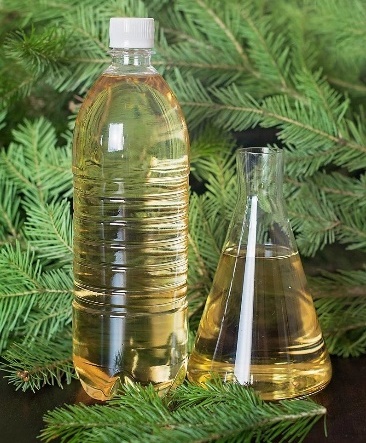
Large volumes of a “natural product” clearly indicate a fake based on refined vegetable oil; plastic containers also do not inspire confidence
Visual method
You can pour the oil into a clean, white, transparent glass container. The genuine product is transparent and almost colorless at room temperature. Sometimes it may have a yellowish or greenish tint. There should be no suspension of mechanical particles, turbidity, or separation of the liquid into fractions. Crystalline precipitation is permissible only if the temperature of the substance is below 15 °C. When heated, the crystals should dissolve.
Using the sense of smell
Here you need to distinguish aromas well. If you have a runny nose, this method will not work. Apply one drop of liquid to a clean cloth. Its smell should not have any irritating notes. Normally it is light and coniferous. Since fir extract has a complex composition, the aroma will constantly change depending on which fraction begins to evaporate.
Test using paper
Drop the contents of the bottle onto white paper.If a greasy stain remains after the liquid has dried, it means the bottle is fake. Most often it is a mixture with conventional vegetable oils or synthetic components.
However, it can also be homemade “fir oil”. The cost of such an “environmentally friendly product” barely exceeds the price of the refined plant extract used to make the “medicinal” product.
At home, a similar remedy is prepared from chopped fir needles and annual shoots. The raw materials are crushed, placed in a jar and filled with refined vegetable oil. Place the container in a water bath and “boil” the needles. Then the solid mass is squeezed out. The result is the cheapest fake, which is often passed off as real fir oil.
During cooking, the beneficial essential substances will evaporate, and the heavy compounds obtained by fir from the soil and air will turn into an oil decoction. It is better not to use such a homemade product for children.

The practice of the Moscow Zoo shows that few people are able to distinguish a fir from a spruce; it is not a fact that the tree growing in the yard is a fir
The healing properties of fir oil for coughs and ARVI
Fir extract has medicinal properties due to its essential components. Substances contained in extracts from coniferous trees can disinfect the air and soothe a sore throat. The downside is the ability to dry out mucous membranes when used in its “pure” form. Therefore, water inhalations with fir oil are often done.
Fir oil for colds
Treatment of colds with fir oil began relatively recently, after the appearance of this product in pharmacies.But the disinfecting phytoncides secreted by coniferous trees have been known for a long time. It’s just that now you don’t need to go to a sanatorium located in a pine grove.
Since the popular name “cold” usually hides a viral disease, a fir preparation will help cope with a secondary microbial infection. It also softens and relieves cough.
The common cold is often called acute tonsillitis, a bacterial disease that used to bear the “name” of sore throat. Here, fir extract can be indispensable, as it kills microorganisms. It is used to lubricate the tonsils. But you should not use the product in its pure form. It is enough to mix a few drops of the drug with vegetable oil.
Fir oil for bronchitis
Can be used in very small quantities. A high concentration of fir oil during bronchial cough during inhalation can cause a reverse reaction: spasm. For children, it is better to use rubbing rather than inhalation.
Fir oil for cough
The use of fir oil is most effective against dry cough at the onset of the disease. This will kill pathogenic organisms that multiply on the inflamed bronchial mucosa. Later, when the inflammation passes and the body begins to get rid of dead tissue, fir extract will not harm. But it won't help either.
For dry, hysterical cough in adults, fir oil mixed with vegetable oil is dripped onto the root of the tongue. For children with bronchitis, it is better to simply place a cloth moistened with liquid next to the pillow.
Fir oil for runny nose
The use of oil for a runny nose is somewhat controversial. The substances contained in it will destroy bacteria.But only those that are in the nasal cavity. In addition, in case of a serious runny nose, it is first suggested to use vasoconstrictor drugs. That is, fir oil, in addition to its disinfectant function, has only one more function - it softens dried crusts. But this happens due to the fact that fir oil is diluted with vegetable oil. Therefore, you can only get by with the latter.
For acute respiratory viral infections and acute respiratory infections
The diagnosis of acute respiratory infections is made when the doctor himself does not know what exactly the patient is sick with. There are cold symptoms, but what caused them is a mystery. These can be protozoa or fungi. It could also be a virus or bacterial infection. The diagnosis of ARVI differs from acute respiratory infections only in that it is clear: the cause of the disease is a virus.
Accordingly, fir preparations are used in the same way as for “colds” and bronchitis, as a symptomatic remedy to ease breathing.
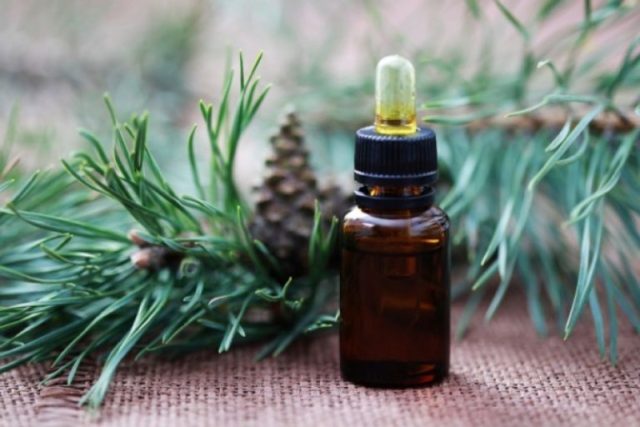
Sometimes bottles are immediately equipped with dispensers, which make it convenient to measure the drug
Indications for use
You can often come across claims that fir oil helps with almost all diseases, including even nail fungus. In fact, the use of the drug is limited. It helps best with respiratory diseases and in the absence of allergies to it.
You can add fir oil to the water when taking a bath. It is believed that at the beginning of the disease this will help to recover. A hot bath for hypothermia or at the onset of the disease will help treatment even without any additives.
Recipes and methods of application
For colds, bronchitis, acute respiratory infections and other diseases affecting the respiratory system, use:
- inhalation;
- instillation into the nose;
- rubbing the chest and outer surface of the nose;
- hot baths.
Sometimes they use juice cocktails with the addition of fir extract. But here we must remember that it is poisonous in large quantities.
Inhalations with fir oil
Fir preparations can be inhaled:
- steam;
- dry;
- oil;
- air.
Oil inhalations are usually performed in clinics. They are based on a fine spray of heated oils. At home, other types are more often used.
Air inhalation - spraying an aerosol of fir oil in the air. It is very close in essence to “dry” or to aromatizing a room.
Fir extract negatively affects the development of the embryo. The drug cannot be used in the first trimester. From the 27th week, theoretically, fir oil can no longer cause harm, but inhalation should only be done after consulting a doctor.
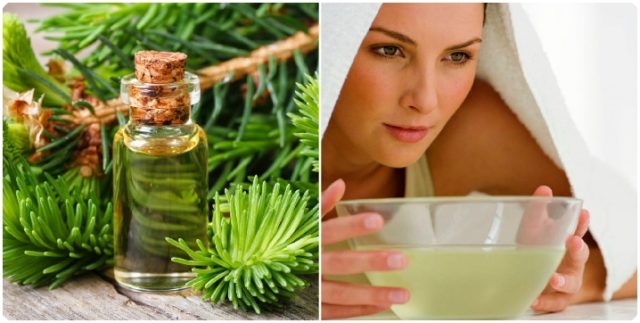
Steam inhalations are the most common in everyday life, and they are also the easiest to perform.
How to make inhalation with fir oil
Steam inhalation is used for diseases of the upper respiratory tract. To carry it out, just pour hot water into a teapot and add a few drops of the drug. The kettle is closed with a lid, the socks are wrapped in a cloth so as not to burn the lips, and the steam is inhaled through the mouth. This method allows you to treat inflamed tonsils and reduce cough in case of bronchial disease.
If you need treatment for a runny nose, a kettle will not work. In this case, hot water is poured into a bowl or pan and oil is also added. The head is covered with a cloth so that the steam does not escape into the air. This method allows you to clean the nasal cavities.
There are also contraindications for steam inhalations.It is undesirable to do them in case of cardiovascular diseases, tuberculosis, or exacerbation of pneumonia. Do not treat with steam or small children. For kids it is better to do “dry” inhalation.
How to do dry inhalation with fir oils
In fact, dry inhalation with fir extract is no different from ordinary disinfectant spraying of the room. It is well suited for very young children who cannot drip fir oil into their nose, but need to clear their maxillary sinuses.
The liquid is simply sprayed onto surfaces in the room. But this is expensive, as it will result in a lot of expense. In order not to waste too much oil, a few drops of the drug are applied to a clean cloth and placed next to the patient.
Inhalation with fir oil through a nebulizer
Using a nebulizer, you cannot inhale with any type of oil, not just fir oil. More precisely, it can be done, but for a very short time. Then you will have to throw out the device and buy a new one. The holes in the nebulizer are too small and the oil will eventually clog them. Moreover, pure fir oil cannot be used for dispersive inhalation, and the mixture with a plant composition is too rough for the device.
Treatment of a runny nose with fir oil
Treatment of a runny nose is carried out in approximately the same way as it was previously done with the help of “Zvezdochka” balm. But if the runny nose is severe, you must first use medications that constrict blood vessels and eliminate mucus. Fir extract can get rid of bacteria, but only if it has the ability to penetrate the nasal cavity. If there is a large amount of mucus, the drug will simply flow out.
Is it possible to put fir oil in the nose?
In its pure form, no. Turpentine, even of the highest purity, in concentrated form will burn the mucous membranes.It is better not to drip fir oil into the nose of children at all, since it is difficult to manually calculate the safe dose. It’s easier to use ready-made nasal drops.
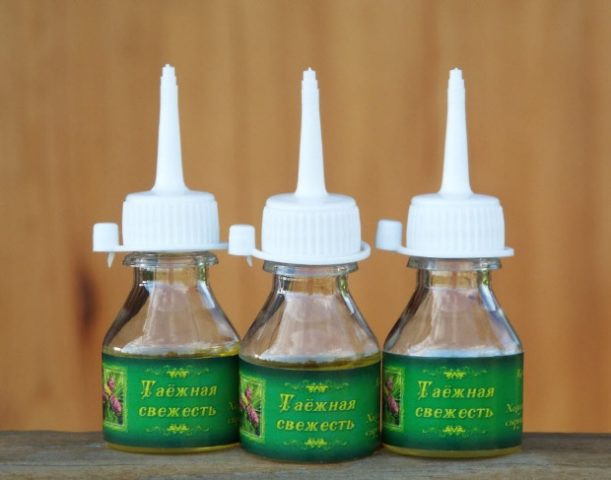
Fir oil is included in these nasal drops only as one of the components; they are ready for use and do not require dilution with other substances
How to dilute fir oil for instillation
For instillation into the nose, fir oil is usually mixed with any refined vegetable oil. More expensive options:
- sea buckthorn;
- calendula;
- wheat germ oil.
Fir and sea buckthorn are usually mixed in a ratio of 1:3. It is not advisable to use this mixture for children. The remaining types are mixed at the rate of 30 ml of any oil per 5 drops of fir oil. For kids, a plant-based one is better suited as a base for nasal drops.
How to drip correctly
The finished mixture is instilled into the nose, cleared of mucus with other drugs. Dose for adults: 3-4 drops in each nostril. Children no more than 2 drops.
The oil is instilled with your head on a pillow so that the liquid can flow deep into the nasal cavity. After a few minutes, you need to lie still so that the product is distributed throughout the mucous membrane.
Baths with fir oil
A bath is taken only if the body temperature is within normal limits. And this procedure is purely preventive in nature. Pour 20 ml of fir extract into 160 liters of hot water, 39-42 °C. You can add foam to the bath. There is no need to specially cook the composition with soap and oil. Solid soap usually begins to smell unpleasant 2-3 days after dilution in water.
A bath will prevent colds as a result of hypothermia. The procedure time is 20 minutes.However, you can simply steam your feet, inhaling fir vapors at the same time.
For children, a bath is made with a water temperature of no more than 39 °C. Since the volume of a bath for a child is smaller than for an adult, oil is added in smaller quantities: about 5 ml per 60 liters.
Another recipe for a bath: add a tablespoon of salt, honey or milk and a few drops of fir preparation to the water. It is better to carry out the procedure before bed, as warm water relaxes.

When taking a bath, you need to monitor the water temperature and time
Rubbing
It is better for children not to take baths, but to rub their chest and nose. To do this, fir oil is mixed with vegetable or internal lamb/goose fat. Thanks to rubbing, the child's body warms up and blood circulation increases. Fir oil slowly evaporates from the skin. Thus, inhalation occurs at the same time. After rubbing the child, you need to wrap him in a blanket.
If you have a runny nose, you can rub the bridge of your nose. In this case, the fumes will also penetrate into the nasal cavity. Do not lubricate the mucous membranes inside with pure fir oil.
Aromatization of the room
Perhaps the most effective way to use oil. A pleasant smell in the room is guaranteed. Aromatization is carried out in the same way as with any other essential oils: using an aroma lamp or hot water. You can also spray an aerosol from a can or place a cloth moistened with oil somewhere, but then it will be no different from “dry” inhalation.
Healing cocktails
There are two recipes for a cocktail with juice and fir oil. In one case, it is advised to take unsweetened juice, in the other - sweet. Cocktail authors agree on only one thing: citrus fruits should not be used.Their juice irritates the mucous membranes. Otherwise the recipes are exactly the same:
- a glass of juice;
- a teaspoon of honey;
- a few drops of fir extract.
Mix everything and consume one hour before meals or 1.5 hours after meals. Frequency – 3 times a day.
The similarity of the recipes suggests a marketing hoax. In addition, fir oil, although weak, is poison. But they used to drink kerosene for colds. And the experience of King Mithridates proves that the human body can gradually adapt to the use of poison.

Pomegranate juice is suitable for cocktails
Rules of application
Before using the drug as a medicine, you must ensure that you are not allergic to it. This is especially true for people with a predisposition to asthma. Any strong odors can cause them to suffocate.
You cannot use fir product in its pure form. It must be diluted with other substances. You can often find advice to mix it with water. But these two fractions do not mix, and this method can only be used when taking baths or steam inhalations.
Taking the drug orally as part of cocktails starts with 6 drops: 2 at a time. Add 1 drop per day.
The maximum amount of oil is no more than 30 drops per day. But the dose is individual and ranges from 9 to 30 drops.
Restrictions and contraindications
Advertising presents “natural” drugs as completely harmless and without side effects. However, the list of contraindications suggests the opposite. Fir extract cannot be used for:
- tuberculosis;
- diseases of the circulatory system;
- heart disease;
- pneumonia;
- pregnancy;
- kidney diseases;
- stomach problems;
- epilepsy;
- liver diseases;
- tumors;
- allergies;
- Cerebral palsy.
Hot baths and warming rubs are contraindicated if you have high blood pressure. Fir preparations are strictly prohibited in the early stages of pregnancy. And later they are used only under the supervision of a doctor.

Redness of the skin is a common sign of an allergy to an irritant.
Symptoms of allergy to fir oil
The main sign of not even an allergy, but of poisoning with fir preparations is a rapid heartbeat. That is why it is recommended to start taking the oil internally with 2 drops. There are more chances to survive.
You can check the body’s reaction to fir oil as follows:
- count your pulse before taking the drug;
- take 2 drops;
- count your pulse after 3-4 hours.
If the number of strikes increases by more than 10, you need to stop. Theoretically, you can take 9 drops daily, but it is better not to do this at all.
If the body reacted normally, the next day the dose is increased and the pulse is checked again. The latter is done every day until the maximum dose of the drug is determined.
Another, more “traditional” way to test for allergies is to rub oil into the skin. If redness appears, fir preparations should not be used.
Conclusion
Fir oil for coughs only helps in combination with other drugs. In fact, it only makes breathing easier.The body either copes with the disease on its own or with the help of other medications.


